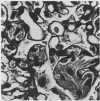Abstract
In a prospective study of renal dysfunction in 60 consecutive allograft recipients treated with cyclosporin and prednisolone routine renal biopsies at one week and one month after transplantation, as well as for all episodes of renal dysfunction, were performed. The one year graft survival of this group was 88%. In a retrospective clinical analysis of these patients 35 episodes of dysfunction due to rejection, defined by a response to antirejection treatment alone, and 30 episodes due to cyclosporin nephrotoxicity, defined by a response to reduction in cyclosporin dose alone, were identified. The morphological findings from these biopsies were compared with 20 samples from routine biopsies taken from patients with stable renal function. All patients diagnosed as having rejection had a diffuse, interstitial mononuclear cell infiltrate (32 of 35) or arteritis (19 of 35), or both. In contrast, focal mononuclear cell infiltrates were common in both patients with nephrotoxicity and those with stable function (17 of 30 and 14 of 20, respectively). There were no important differences between biopsies from those with nephrotoxicity and those with stable function, except that arteriolar hyalinosis was considerably more common in the nephrotoxic patients than in those with stable function. Many patients with stable function were, in retrospect, in a state of stable mild nephrotoxicity. In our experience rejection should only be diagnosed when there is at least a diffuse interstitial infiltrate or an arteritis. Focal mononuclear cell infiltrates do not denote rejection. The development of arteriolar lesions in the absence of rejection is indicative of nephrotoxicity.
Full text
PDF







Images in this article
Selected References
These references are in PubMed. This may not be the complete list of references from this article.
- Bonser R. S., Adu D., Franklin I., McMaster P. Cyclosporin-induced haemolytic uraemic syndrome in liver allograft recipient. Lancet. 1984 Dec 8;2(8415):1337–1337. doi: 10.1016/s0140-6736(84)90842-0. [DOI] [PubMed] [Google Scholar]
- Burdick J. F., Beschorner W. E., Smith W. J., McGraw D., Bender W. L., Williams G. M., Solez K. Characteristics of early routine renal allograft biopsies. Transplantation. 1984 Dec;38(6):679–684. doi: 10.1097/00007890-198412000-00026. [DOI] [PubMed] [Google Scholar]
- Calne R. Y., White D. J., Thiru S., Evans D. B., McMaster P., Dunn D. C., Craddock G. N., Pentlow B. D., Rolles K. Cyclosporin A in patients receiving renal allografts from cadaver donors. Lancet. 1978 Dec 23;2(8104-5):1323–1327. doi: 10.1016/s0140-6736(78)91970-0. [DOI] [PubMed] [Google Scholar]
- Homan W. P., Fabre J. W., Williams K. A., Millard P. R., Morris P. J. Studies on the immunosuppressive properties of cyclosporin a in rats receiving renal allografts. Transplantation. 1980 May;29(5):361–366. doi: 10.1097/00007890-198005000-00003. [DOI] [PubMed] [Google Scholar]
- Neild G. H., Ivory K., Williams D. G. Glomerular thrombosis and cortical infarction in cyclosporin-treated rabbits with acute serum sickness. Br J Exp Pathol. 1984 Feb;65(1):133–144. [PMC free article] [PubMed] [Google Scholar]
- Neild G. H., Reuben R., Hartley R. B., Cameron J. S. Glomerular thrombi in renal allografts associated with cyclosporin treatment. J Clin Pathol. 1985 Mar;38(3):253–258. doi: 10.1136/jcp.38.3.253. [DOI] [PMC free article] [PubMed] [Google Scholar]
- Shulman H., Striker G., Deeg H. J., Kennedy M., Storb R., Thomas E. D. Nephrotoxicity of cyclosporin A after allogeneic marrow transplantation: glomerular thromboses and tubular injury. N Engl J Med. 1981 Dec 3;305(23):1392–1395. doi: 10.1056/NEJM198112033052306. [DOI] [PubMed] [Google Scholar]
- Sibley R. K., Rynasiewicz J., Ferguson R. M., Fryd D., Sutherland D. E., Simmons R. L., Najarian J. S. Morphology of cyclosporine nephrotoxicity and acute rejection in patients immunosuppressed with cyclosporine and prednisone. Surgery. 1983 Aug;94(2):225–234. [PubMed] [Google Scholar]
- Solez K., Morel-Maroger L., Sraer J. D. The morphology of "acute tubular necrosis" in man: analysis of 57 renal biopsies and a comparison with the glycerol model. Medicine (Baltimore) 1979 Sep;58(5):362–376. [PubMed] [Google Scholar]
- Strom T. B., Loertscher R. Cyclosporin-induced nephrotoxicity. Inevitable and intractable? N Engl J Med. 1984 Sep 13;311(11):728–729. doi: 10.1056/NEJM198409133111109. [DOI] [PubMed] [Google Scholar]
- Taube D. H., Neild G. H., Williams D. G., Cameron J. S., Hartley B., Ogg C. S., Rudge C. J., Welsh K. I. Differentiation between allograft rejection and cyclosporin nephrotoxicity in renal-transplant recipients. Lancet. 1985 Jul 27;2(8448):171–174. doi: 10.1016/s0140-6736(85)91495-3. [DOI] [PubMed] [Google Scholar]
- Thiel G., Harder F., Lörtscher R., Brünisholz M., Landmann J., Brunner F., Follath F., Wenk M., Mihatsch M. Cyclosporin A used alone or in combination with low-dose steroids in cadaveric renal transplantation. Klin Wochenschr. 1983 Oct 17;61(20):991–1000. doi: 10.1007/BF01537497. [DOI] [PubMed] [Google Scholar]





